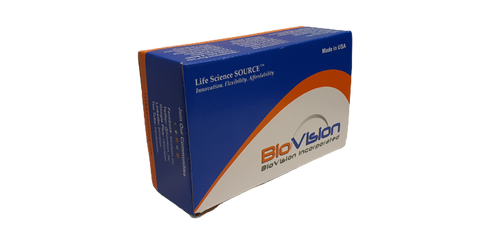Product Description
Carbonic anhydrases (CAs) are a large family of zinc metalloenzymes. CAs form a family of enzymes that catalyze the rapid interconversion of carbon dioxide and water to bicarbonate and protons (or vice versa), a reversible reaction that occurs rather slowly in the absence of a catalyst. One of the functions of the enzyme in animals is to interconvert carbon dioxide and bicarbonate to maintain acid-base balance in blood and other tissues, and to help transport carbon dioxide out of tissues. The active site of most carbonic anhydrases contains a zinc ion. There are at least five distinct CA families (, , , and ). Carbonic anhydrase 9 (CA9 / CAIX), also known as Membrane antigen MN (MN), Renal cell carcinoma-associated antigen G250, which belongs to the alpha-carbonic anhydrase family. CA9 / CAIX with an optimal activity at pH 6.49. Reversible hydration of carbon dioxide. CA IX participates in pH regulation. CA9 may be involved in the control of cell proliferation and transformation. CA-IX appears to be a novel specific biomarker for a cervical neoplasia.
Biovision | 7478 | Human CellExp Carbonic Anhydrase 9/CA9 human recombinant DataSheet
Biomolecule/Target: Carbonic Anhydrase 9/CA9
Synonyms: CAIX, CA9, CA-IX, G250, MN, P54/58N, pMW1
Alternates names: CAIX, CA9, CA-IX, G250, MN, P54/58N, pMW1
Taglines: A zinc metalloenzyme serving as a novel specific biomarker for a cervical neoplasia.
NCBI Gene ID #: 2921
NCBI Gene Symbol: GRO-
Gene Source: Human
Accession #: P19876
Recombinant: Yes
Source: HEK293 cells
Purity by SDS-PAGEs: 98%
Assay: SDS-PAGE
Purity: N/A
Assay #2: N/A
Endotoxin Level: <1 EU/g by LAL method
Activity (Specifications/test method): N/A
Biological activity: Measured by its esterase activity. The specific activity is measured with 1 mM 4-Nitrophenyl acetate and 2.5 g enzyme at 400 nm in 100 L of 12.5 mM Tris, 75 mM NaCl, pH 7.5. The specific activity is > 15 pmoles / min / g.
Results: Measured by its esterase activity. The specific activity is measured with 1 mM 4-Nitrophenyl acetate and 2.5 g enzyme at 400 nm in 100 L of 12.5 mM Tris, 75 mM NaCl, pH 7.5. The specific activity is > 15 pmoles / min / g.
Binding Capacity: N/A
Unit Definition: N/A
Molecular Weight: This protein is fused with 6×His tag at the C-terminus, has a calculated MW of 41.2 kDa. The predicted N-terminus is Gln 38. DTT-reduced Protein migrates as 53-54 kDa due to glycosylation.
Concentration: N/A
Appearance: Lyophilized
Physical form description: Lyophilized from 0.22 m filtered solution in 20 mM MES and 100 mM NaCl, pH 6.5. Normally Mannitol or Trehalose is added as protectants before lyophilization.
Reconstitution Instructions: Centrifuge the vial prior to opening. Reconstitute in sterile PBS, pH 7.4 to a concentration of 50 µg/ml. Do not vortex. This solution can be stored at 2-8°C for up to 1 month. For extended storage, it is recommended to store at -20°C.
Amino acid sequence: N/A
 Euro
Euro
 USD
USD
 British Pound
British Pound
 NULL
NULL












